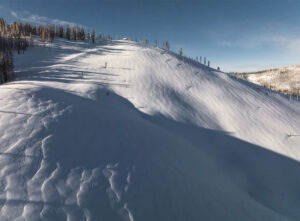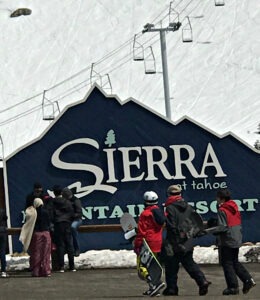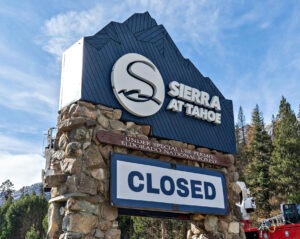For decades, an abundance of beautiful tree-lined runs made Sierra-at-Tahoe a real joy for exuberant skiers and snowboarders.

That joy was wiped out in the summer of 2021 when the highly destructive Caldor Fire torched 1,600 acres of Sierra-at-Tahoe’s terrain. Sadly, in the aftermath, the trees were badly burned and eventually removed, leaving behind a new, open landscape that left some areas almost unrecognizable to locals who frequented the Lake Tahoe ski resort for decades.
However, Sierra-at-Tahoe is looking to someday see the return of those gorgeous tree-lined runs. The resort is replanting thousands of seedlings that will one day replace the trees lost in the horrendous blaze that at one time threatened to burn South Lake Tahoe to the ground.
In partnership with the U.S. Forest Service and the El Dorado Resource Conservation District, the seedlings have been planted in the West Bowl area of Sierra-at-Tahoe’s slopes. The goal is to create a new tree skiing experience.
The resort was founded by brothers Ray and Floyd Barrett. Sierra-at-Tahoe ski resort first opened in 1946 as Sierra Ski Ranch.
REPLENISHING THE WEST BOWL: The West Bowl area was the hardest hit by the Caldor Fire. Following assessments, hazardous trees had to be cut, decked, and hauled to Tahoe Forest Products sawmill near Carson City with few scattered log truck loads remaining.

As new trees take root, this multi-year effort will unfold over seasons and generations to come, but the vision is starting to take shape.
“A key to great off-piste (glade) skiing is tree spacing. Forests naturally grow in clusters and patches, not perfect grids, so we’re planting the trees in a way to mimic the unique natural feel, look, and flow you would expect to find at a ski resort,” said Mark Egbert, district manager of the El Dorado and Georgetown Divide Resource Conservation Districts.
TREE PLANTING TECHNIQUES: The mixture of trees includes Fir and Jeffrey Pine, and includes smaller numbers of White Fir, Western White Pine, and Sugar Pine. Two planting techniques are being used: cluster and uniform.
In some areas, a uniform planting strategy will be used – trees will be densely and evenly spaced to help act as natural trail markers, provide shelter from winds, improve visibility on storm days and help prevent cornice formation.
Other areas will use cluster planting, where trees are grouped irregularly with open space between them. This approach mirrors the natural patchwork of a healthy forest and will help restore some of the incredible tree skiing and riding Sierra has long been
“From what we’ve seen so far, the forest is showing strong signs of regeneration, which is great to see,” said Jesse Cone, silviculturist with the Placerville Ranger District of the Eldorado National Forest. “This next phase is about intentional planting both in terms of location and the species of conifers we reintroduce.”
AN HISTORIC FIRE: In November 2021, Scot Rogers, district ranger with the Eldorado National Forest, said the wildfires grazed the edges of other ski areas before. However, no ski resort in the U.S. or perhaps the world has ever suffered the extensive damage like Sierra.

“There’s really no playbook to follow, so we’re making it up as we go,” Sierra-at-Tahoe GM John Rice said after the fire. “This isn’t the last fire that’s going to hit a ski area, so the whole world is watching us.”
The overall damage from the Caldor Fire was so extensive that to the dismay of its many loyal skiers and riders, Sierra-at-Tahoe was forced to shut down for the entire 2021-22 season.
The fire affected 1,600 of the resort’s 2,000 acres, damaged lifts towers, haul ropes, terrain park features, four new snowcats, and a maintenance building, which housed many of the crews’ tools and personal belongings, some that had been passed down through generations.